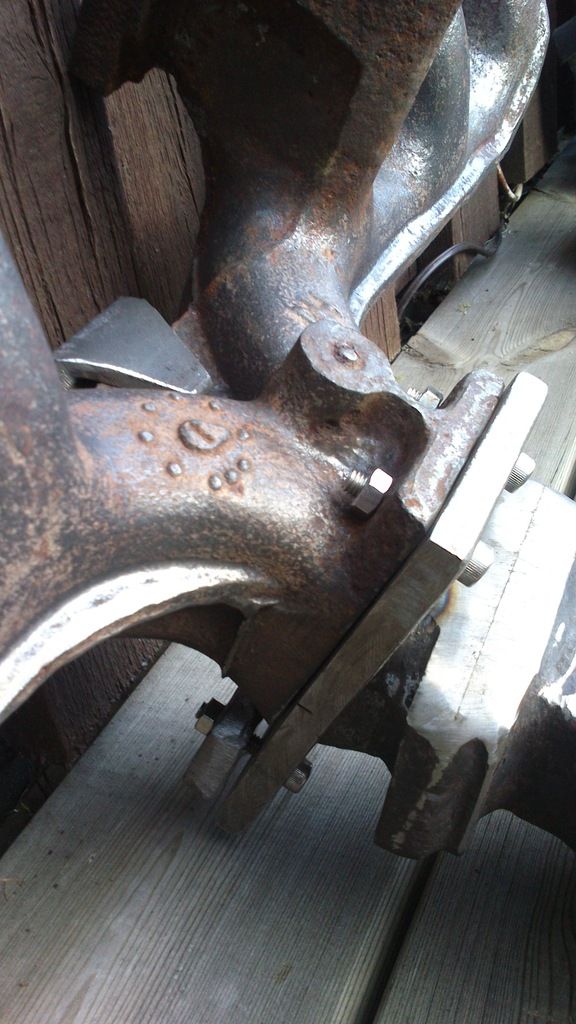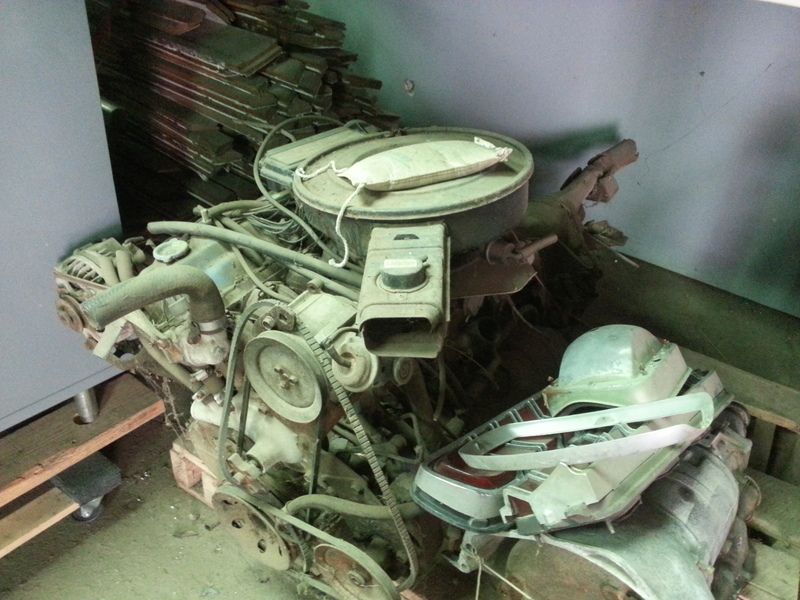Slant 6 Turbo 68Dart Project
There are several things that go into driveability on the street. The main one is camshaft selection. These guys who can't WAIT to get that slant six out of Granny's Duster, so they can swap a 360 into it, are setting themselves up for a lifetime of driveability issues, because the 360 they swap into her 3,300-pound Duster, will very likely spend its life with a camshaft that will give it a rough idle, a high rpm idle, and require a loose torque converter for decent driveability. All of that goes together to make for some not-so-relaxed cruising and poor fuel economy. This camshaft selection will require a rear axle final drive in the low 4's (4.10:1) or deeper (4:56?) or deeper, yet, in order to maximize acceleration at the strip. Then, if you want to make it a hiway cruiser for a trip, or just relaxed freeway cruising, a 3.08 or 3.23-geared center section will be necessary.
This absolutely dictates that you install an 8.75" housing in the car. They don't give those away anymore... for some reason (availability?) they have become unduly expensive.
Slant six cars have an advantage here, in that both Ryan Peterson's turbo car and Tom Wolfe's similar Dart, were tested with a variety of final drive ratios and ended up being quicker and faster using 2.73:1 ring and pinion gears than any other. What that means is, if you have a turbocharged slant six, you have a "one size fits all" final drive situation, which also means, you don't have an use for an expensive 8.75" housing that will accommodate a drop-out center section; you can use a cheap, readily-available 8.25" hiway geared rear end out of a Late '70's Duster, Aspen, or other A Body car. Saves you a ton of cash, there... Maybe enough to buy the upper control arms, spindles and disk brakes to change your front end over to LBP wheels...
Camshaft selection is surely an engine parameter that has a tremendous effect on driveability. Turbo motors of all kinds, don't work well if they are subjected to much overlap. The boost goes out the exhaust valve, which exacerbates the problem of making enough exhaust to spool the turbo effectively. Two avenues of approach are used to prevent this situation (that I am aware of.) Lobe center separation is wider than would be desirable on a naturally-aspirated motor. That minimizes overlap, by itself. It also makes the idle smoother. The other thing that works to make for less overlap is, reducing the amount of time (in degrees of rotation) that the valves are open. Very mild timing is part and parcel of turbo camshafts, for the expressed purpose of minimizing overlap. This smooths the idle further, and makes for an engine with impeccable manners; tons of low end and mid-range torque.
Now, you have an engine that is geared for the road, but still performs well on the drag strip, and idles like your grandmorther's slant six...
There are two other factors that can affect driveabilty, and will...
Spark advance and fuel metering. The subject of spark advance on boosted engines, is far beyond the scope of my understanding; In NO WAY, do I have sufficient knowledge to discuss it, even in a rudimentary way, so, I will leave that to smarter minds... yours, maybe. The only caveat here is, that in order to stay our of harm's (detonation) way, be very conservative with spark advance, keeping it ALWAYS less than 18 degrees if boost is present... even a little.
Fuel curves are vitally important to good driveability, but we have A/F ratio meters to assist us in tuning, but even with their help, it's not easy.... but, time and patience will put it into the realm of possibility. It just take some considerable effort.
The amount of boost present is the difference between a 300, 400 and 500 hp motor; I don't think their driveability would be much different. Just their lifespans... LOL!
My 2-cents... YMMV...:happy1:
There are several things that go into driveability on the street. The main one is camshaft selection. These guys who can't WAIT to get that slant six out of Granny's Duster, so they can swap a 360 into it, are setting themselves up for a lifetime of driveability issues, because the 360 they swap into her 3,300-pound Duster, will very likely spend its life with a camshaft that will give it a rough idle, a high rpm idle, and require a loose torque converter for decent driveability. All of that goes together to make for some not-so-relaxed cruising and poor fuel economy. This camshaft selection will require a rear axle final drive in the low 4's (4.10:1) or deeper (4:56?) or deeper, yet, in order to maximize acceleration at the strip. Then, if you want to make it a hiway cruiser for a trip, or just relaxed freeway cruising, a 3.08 or 3.23-geared center section will be necessary.
This absolutely dictates that you install an 8.75" housing in the car. They don't give those away anymore... for some reason (availability?) they have become unduly expensive.
Slant six cars have an advantage here, in that both Ryan Peterson's turbo car and Tom Wolfe's similar Dart, were tested with a variety of final drive ratios and ended up being quicker and faster using 2.73:1 ring and pinion gears than any other. What that means is, if you have a turbocharged slant six, you have a "one size fits all" final drive situation, which also means, you don't have an use for an expensive 8.75" housing that will accommodate a drop-out center section; you can use a cheap, readily-available 8.25" hiway geared rear end out of a Late '70's Duster, Aspen, or other A Body car. Saves you a ton of cash, there... Maybe enough to buy the upper control arms, spindles and disk brakes to change your front end over to LBP wheels...
Camshaft selection is surely an engine parameter that has a tremendous effect on driveability. Turbo motors of all kinds, don't work well if they are subjected to much overlap. The boost goes out the exhaust valve, which exacerbates the problem of making enough exhaust to spool the turbo effectively. Two avenues of approach are used to prevent this situation (that I am aware of.) Lobe center separation is wider than would be desirable on a naturally-aspirated motor. That minimizes overlap, by itself. It also makes the idle smoother. The other thing that works to make for less overlap is, reducing the amount of time (in degrees of rotation) that the valves are open. Very mild timing is part and parcel of turbo camshafts, for the expressed purpose of minimizing overlap. This smooths the idle further, and makes for an engine with impeccable manners; tons of low end and mid-range torque.
Now, you have an engine that is geared for the road, but still performs well on the drag strip, and idles like your grandmorther's slant six...
There are two other factors that can affect driveabilty, and will...
Spark advance and fuel metering. The subject of spark advance on boosted engines, is far beyond the scope of my understanding; In NO WAY, do I have sufficient knowledge to discuss it, even in a rudimentary way, so, I will leave that to smarter minds... yours, maybe. The only caveat here is, that in order to stay our of harm's (detonation) way, be very conservative with spark advance, keeping it ALWAYS less than 18 degrees if boost is present... even a little.
Fuel curves are vitally important to good driveability, but we have A/F ratio meters to assist us in tuning, but even with their help, it's not easy.... but, time and patience will put it into the realm of possibility. It just take some considerable effort.
The amount of boost present is the difference between a 300, 400 and 500 hp motor; I don't think their driveability would be much different. Just their lifespans... LOL!
My 2-cents... YMMV...:happy1:

